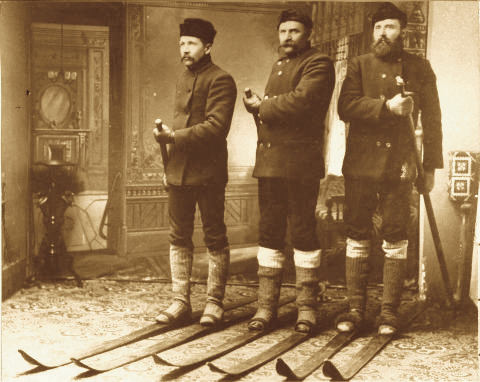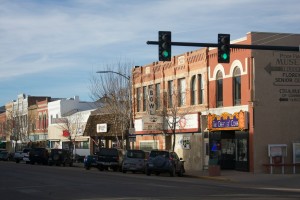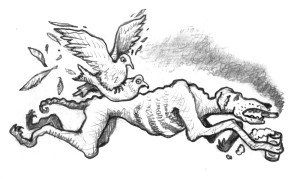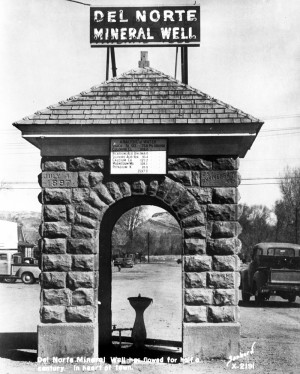By Phil Sasso
Winter storms are fierce. In the old days, my fingers didn’t freeze nearly as fast as these days. Forty years have taken their toll in many ways. Now in the middle of a storm, the truck becomes the mothership, the last warm, windless place. Why am I going out in this? Powder snow. So, given my elderly circulation I look to get as dressed as I can inside the truck – a trick behind the wheel. You can position the doors to provide lee from the wind, or you can choose the windless side of your vehicle. Boots, buckles, snaps, zippers and all manner of clothing have a sequence. Then it’s off to the trailhead and a climb.
 People in Scandinavian countries used to put seal skins on the bottom of their skis. The fur was smooth and let the skis slide forward, and stuck to prevent the skis from slipping back. This started a long time ago. Now people use synthetic skins to climb up mountains, then take them off to ski down places you might admire in distant views. In winter, this is usually a day trip. In spring, skiers descend one or more high peaks from a high base camp.
People in Scandinavian countries used to put seal skins on the bottom of their skis. The fur was smooth and let the skis slide forward, and stuck to prevent the skis from slipping back. This started a long time ago. Now people use synthetic skins to climb up mountains, then take them off to ski down places you might admire in distant views. In winter, this is usually a day trip. In spring, skiers descend one or more high peaks from a high base camp.
Winter is quiet in the trees. The only place I’ve experienced more solitude is under the water. The same water, piled up high on boughs and forest floors. After all the fury at your trailhead, you enter the shelter and quiet of forest. Some tours start up above timberline, so you get the full effect of winter until you descend into tree line. With any luck, someone has broken trail for you. You can follow their work. It’s hard work breaking trail. In the old days, friends and I would take turns at the front, sharing the work like cyclists in a pace line taking turns with the wind. Now with the wisdom of age, I see how important it is not to make first tracks into a drainage. Second team up has the trail broken, and there is still plenty of untracked snow to enjoy. A slacker move, but I’ve already paid with forty years of trail breaking. C‘mon kids, give grandpa a break.
You warm to the work, unzipping and/or shedding layers as you go. This process will reverse when you climb up out of the trees. Drink water every chance you get. Another fine sound rare to trees in winter comes after a hard push when you stop for a rest. When breathing becomes regular you might hear the sound of your pulse in your ears. Then back to the trail, skis sliding along. It always feels like church – a big cathedral, really.
There’s not much to smell in winter, save the pine forest scent and maybe aromas from a thermos you’ve brought along. The sights are many and memorable. Poets will have a field day on their field day. Big pillows of fresh snow piled cossack hat-high on boughs. Keep your hood up or risk an occasional neckful. When it’s still snowing the flakes can seem as big as poker chips. In sunlight the snow will sparkle. When it’s cold enough the air will sparkle. Don’t believe me, go see for yourself. All manner of shapes and swirls become even more dramatic as you get above the trees. Now the wind is boss.
Sastruga, a Russian word for the windswept snowscapes on the taiga also occurs along the Continental Divide here in our amazing backyard. All manner of other streamlined shapes: whale, dolphin and sweeping scoops occur on the leeward side of rocks and scrub vegetation. Avalanche control teams know the term saltation. It’s when the wind picks up loose snow and runs it across the surface, proof that avalanche danger builds even when it’s not snowing. It’s the same problem on a newly plowed road that fills in due to the wind load. Many of us have had to fight that problem, even in our driveways and walkways. Where’s the snow going? It’s going to slow down and pile up on the leeward slope. There lurks the good, deep skiing. The other term for wind action is turbulent suspension, aka a whiteout. You should have figured this out before skinning up to the tundra or driving across South Park. Run away.
So there you are, atop the run you were after. Avalanche danger has been assessed, a plan concocted, your ski tips over the edge as you contemplate your first turn. Less dramatic but equally joyful are less severe pitches in meadows, treed glades, sometimes down along a streambed.
Spring touring. Sometimes you can actually start off afoot with your skis on your pack, in shorts and a T-shirt. If the snow is frozen deep enough, you can walk on it and keep your feet light. In places the wind will blow pine needles into a carpet on the snow. You pass marsh marigolds and the beginning of runoff. It’s good to pack extra socks. You’ll eventually skin up the mountainside. Often in even the biggest snow years there will be windblown ridges. You can walk up the windward side easily, then ski down the loaded leeward.
There are many books on alpine flora, and every once in a while I am surprised by a species new to me. Another wondrous sight you may have seen while driving over mountain passes is called firnspiegel, German for the phenomenon of a thin ice layer across the snow. It’s also called glacier fire and firn mirror. It’s about as thin as a piece of cardboard and as you ski, it feels like a scratch on your shins – not uncomfortable, and leaving your pants intact. Underneath this, your feet feel soft snow, somewhere between what you might feel while standing on a feather pillow or in a plate of pumpkin pie filling. The variety of sensations underfoot might be the most wonderful sensation. Deep powder brushes and caresses; warm snow has its own message. Have fun, hope to see you on top.
Phil Sasso lives and plays in Salida – you’ll probably be passing him on a nearby trail.




